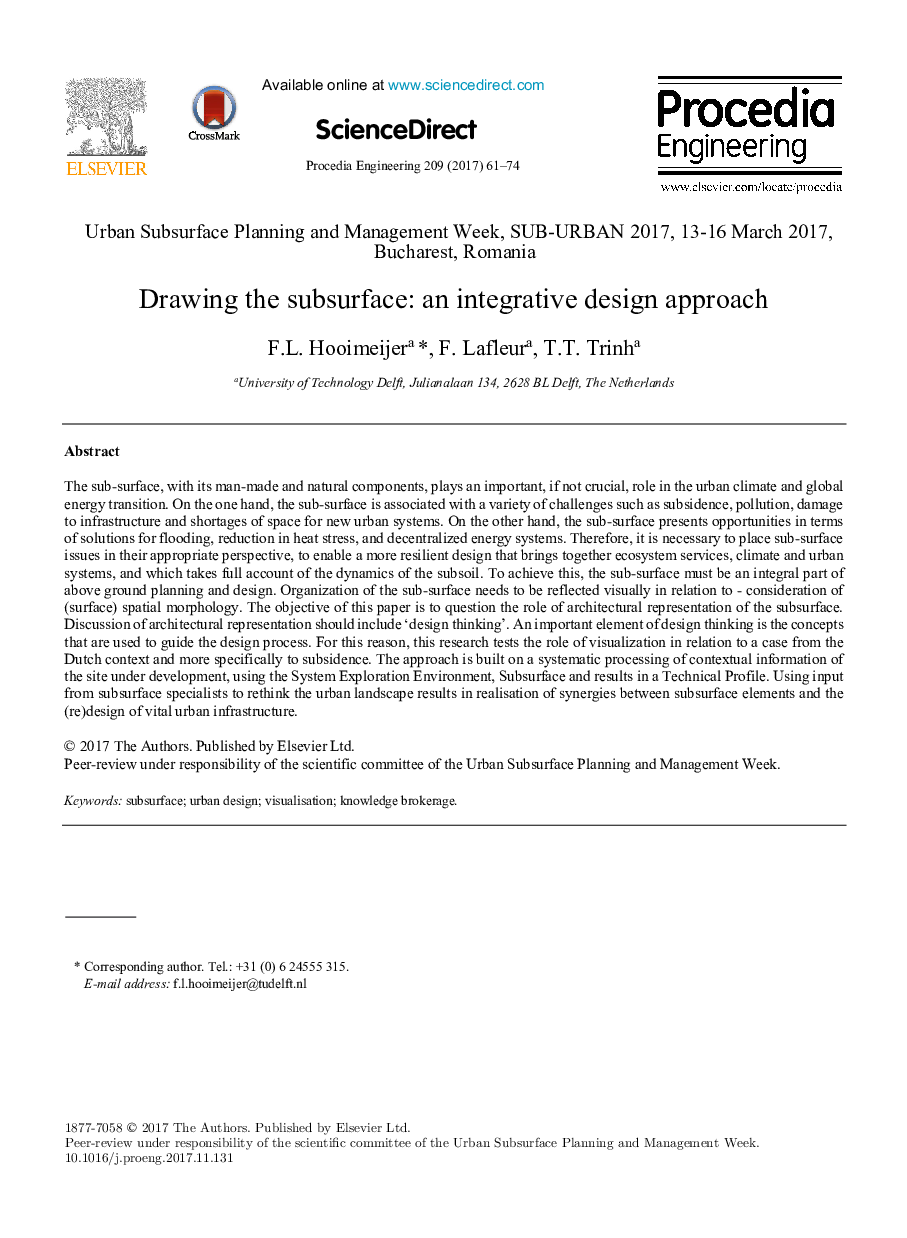| کد مقاله | کد نشریه | سال انتشار | مقاله انگلیسی | نسخه تمام متن |
|---|---|---|---|---|
| 7226901 | 1470617 | 2017 | 14 صفحه PDF | دانلود رایگان |
عنوان انگلیسی مقاله ISI
Drawing the subsurface: an integrative design approach
ترجمه فارسی عنوان
طراحی زیرزمینی: رویکرد طراحی یکپارچه
دانلود مقاله + سفارش ترجمه
دانلود مقاله ISI انگلیسی
رایگان برای ایرانیان
کلمات کلیدی
زیر زمین، طراحی شهری، تجسم، کارگزاری دانش،
ترجمه چکیده
زیر سطح با اجزای ساختاری و طبیعی آن نقش مهمی یا نه حیاتی در محیط زیست شهری و انتقال انرژی جهانی دارد. از یک طرف، زیر سطح با چالش های مختلفی از قبیل تخلیه، آلودگی، آسیب به زیرساخت ها و کمبود فضا برای سیستم های شهری جدید مرتبط است. از سوی دیگر، زیر سطح ارائه می دهد فرصت های از نظر راه حل برای سیل، کاهش استرس گرما، و سیستم های انرژی غیر متمرکز. بنابراین، لازم است مسائل زیر سطحی را در دیدگاه مناسب خود قرار دهیم تا یک طرح انعطاف پذیر را که خدمات اکوسیستمی، سیستم آب و هوا و سیستم های شهری را به ارمغان می آورد، فراهم سازد و از دینامیک زیرزمینی کامل برخوردار باشد. برای رسیدن به این هدف، زیر سطح باید جزء جدایی ناپذیر از برنامه ریزی و طراحی زمین باشد. سازمان سطح زیر باید به صورت بصری در رابطه با - توجه به مورفولوژی فضایی (سطح) منعکس شود. هدف این مقاله این است که نقش نمایندگی معماری زیر زمین را مورد سوال قرار دهد. بحث نمایندگی معماری شامل "تفکر طراحی" است. یک عنصر مهم تفکر طراحی مفاهیمی است که برای هدایت روند طراحی استفاده می شود. به همین دلیل، در این تحقیق نقش تجسم در رابطه با یک مورد از زمینه هلندی و به طور خاص به فروپاشی تست شده است. این رویکرد بر روی پردازش سیستماتیک اطلاعات متنی سایت توسعه یافته ساخته شده است، با استفاده از محیط اکتشاف سیستم، زیرسطحی و نتایج یک مشخصات فنی ساخته شده است. با استفاده از ورودی متخصصان زیر زمین به بازنگری چشم انداز شهری، تحقق هم افزایی میان عناصر زیرزمینی و (دوباره) طراحی زیربنای حیاتی شهری حاصل می شود.
موضوعات مرتبط
مهندسی و علوم پایه
سایر رشته های مهندسی
مهندسی (عمومی)
چکیده انگلیسی
The sub-surface, with its man-made and natural components, plays an important, if not crucial, role in the urban climate and global energy transition. On the one hand, the sub-surface is associated with a variety of challenges such as subsidence, pollution, damage to infrastructure and shortages of space for new urban systems. On the other hand, the sub-surface presents opportunities in terms of solutions for flooding, reduction in heat stress, and decentralized energy systems. Therefore, it is necessary to place sub-surface issues in their appropriate perspective, to enable a more resilient design that brings together ecosystem services, climate and urban systems, and which takes full account of the dynamics of the subsoil. To achieve this, the sub-surface must be an integral part of above ground planning and design. Organization of the sub-surface needs to be reflected visually in relation to - consideration of (surface) spatial morphology. The objective of this paper is to question the role of architectural representation of the subsurface. Discussion of architectural representation should include 'design thinking'. An important element of design thinking is the concepts that are used to guide the design process. For this reason, this research tests the role of visualization in relation to a case from the Dutch context and more specifically to subsidence. The approach is built on a systematic processing of contextual information of the site under development, using the System Exploration Environment, Subsurface and results in a Technical Profile. Using input from subsurface specialists to rethink the urban landscape results in realisation of synergies between subsurface elements and the (re)design of vital urban infrastructure.
ناشر
Database: Elsevier - ScienceDirect (ساینس دایرکت)
Journal: Procedia Engineering - Volume 209, 2017, Pages 61-74
Journal: Procedia Engineering - Volume 209, 2017, Pages 61-74
نویسندگان
F.L. Hooimeijer, F. Lafleur, T.T. Trinh,
